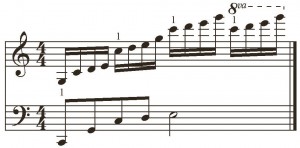The Church Pianist: Adding Runs to Hymns (Example #1)
I enjoy adding runs to hymns. A lot of pianists have asked me the following questions about runs over the years:
1. Where can I add a run?
2. What notes do I use?
3. Do I start the run on the word or after the word?
4. How do I make the run sound like it fits?
5. What fingering do I use?
6. Do I use one or two hands for this run?
Excellent questions! I will attempt to answer these questions as I go through this series of articles on adding runs to hymns.
Runs consist of either arpeggios (broken chords) or scales. Ew….got to know your theory! (Another lesson) 🙂
1. Arpeggios look like this… (notes on treble staff below)

*Special note: Did you notice this particular arpeggio is the second inversion of a C chord with a passing tone sprinkled in? Hmm…I feel more theory lessons coming. That’s ok… a little at a time, right?!
*I’ll show an example of a scale used as a run in upcoming articles.
Some pianists find “adding their own runs” to hymns or playing runs in hymn arrangements to be rather difficult. Let me give you a helpful suggestion…isolate the run…turn it into a technical exercise and learn it well.
When playing runs or anything else for that matter, it is extremely important to use correct fingering. Many church pianists never had the proper training in this area…making it difficult for them to play in a smooth style. It’s ok..not your fault. I’ll provide fingering suggestions on today’s example of a run…to help you produce a flowing style. This first example will use a right hand arpeggio in an octave format (spread).
Editor notes for today’s example:
The example contains the final phrase of Trust and Obey, written in congregational style.
The run occurs on the second syllable of the word “Je-sus”
Notice the ritarando marking (rit.) starting ahead of the run… so the run won’t sound rushed as though it was just carelessly thrown in. I’ll provide an audio link for this example.
The measure containing the run has an extra beat to allow time for the run. (This isn’t always necessary)
Click on the following…Runs in Hymns (Example #1)
Link: Adding runs to hymns Example Two
Tags: adding runs to hymns, church pianists, pianists, runs in hymns
Thanks so much for the helpful suggestions. I like being able to both see the notes written out and hear how it’s supposed to sound. One thing that has helped me as I try to apply these wonderful tips is to record myself. It’s usually a problem with timing, so I can hear if I’m too fast, too slow, etc. I don’t comment often, but I appreciate your website so much. I have read almost all of your articles and posts since I found it. I do pray the Lord allows you to continue sharing your abilities. I attend a very small church in a very small town, and do not have other “Hymn style” piano players around me to learn from. So websites like yours are an amazing blessing!
Just wading through my website for loose ends and came across this wonderful note! THANK YOU so much for the encouragement! You are a blessing! Sorry this is SO late in coming…I somehow overlooked it in my correspondence.
HI, I ran into this article “The Church Pianist: Adding Runs to Hymns” here on the website. It said that other articles on this subject will be published but I don’t see any. Have these been published and if so where can I find them? Thanks.
Still searching for more articles on adding runs to music since 2017! Thank you so much…